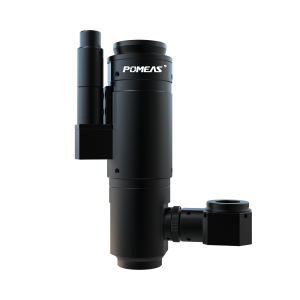Variable-magnification lenses, as a powerful visual inspection lens, play an important role in the field of automated measurement with its ability to flexibly adjust the magnification within a certain range. This lens not only enhances the flexibility and accuracy of measurement, but also greatly broadens the application range of automated inspection systems.


Features of the zoom lens:
1, continuous or segmented zoom: the zoom lens allows the user to adjust the lens magnification continuously or in segments within a preset range according to actual needs. This flexibility allows the same set of measurement systems to respond to a variety of different sizes and accuracy of the inspection task, without the need to frequently change the lens or adjust the equipment.
2, high-resolution imaging: even in the process of magnification changes, the zoom lens can also maintain a high imaging resolution, to ensure the accuracy and reliability of the measurement data. This is particularly important for the need to accurately capture product details or tiny features of the application scene.
3, fast response and positioning: in the automated production line, time is efficiency. The zoom lens usually has a fast response and precise positioning capabilities, can quickly adjust to the required magnification, and accurately aligned with the detection target, thereby improving measurement efficiency.
Applications:
1. Dimensional Measurement: In automated measurement systems, the zoom lens automatically adjusts to the appropriate magnification based on the size of the product to be measured, ensuring accurate results. This capability enables the system to cope with a wide range of dimensional measurement tasks, from tiny components to large parts.
2. Defect Detection: In the field of defect detection, the zoom lens is able to zoom in on tiny defects on the surface of the product, such as scratches, cracks, stains, etc., so that these defects are more clearly visible in the image. By combining advanced image processing algorithms, the system is able to automatically identify and categorize these defects, improving detection efficiency and accuracy.
3. Quality control: In the manufacturing industry, quality control is an important part of ensuring product quality. The zoom lens can be applied to all aspects of the production line to conduct comprehensive inspection of raw materials, semi-finished products and finished products. Through real-time monitoring of key parameters such as product size, shape and surface quality, the system is able to detect and correct potential quality problems in a timely manner and reduce the rate of defective products.
4. Scientific research and experiments: In addition to industrial applications, zoom lenses are also widely used in scientific research and experimental fields. In microscope observation, cell culture, material analysis and other scenarios, the zoom lens can provide clear images and flexible magnification options to help researchers gain a deeper understanding of the characteristics and behavior of the experimental object.
Product recommendation
TECHNICAL SOLUTION
MORE+You may also be interested in the following information
FREE CONSULTING SERVICE
Let’s help you to find the right solution for your project!


 ASK POMEAS
ASK POMEAS  PRICE INQUIRY
PRICE INQUIRY  REQUEST DEMO/TEST
REQUEST DEMO/TEST  FREE TRIAL UNIT
FREE TRIAL UNIT  ACCURATE SELECTION
ACCURATE SELECTION  ADDRESS
ADDRESS Tel:+ 86-0769-2266 0867
Tel:+ 86-0769-2266 0867 Fax:+ 86-0769-2266 0867
Fax:+ 86-0769-2266 0867 E-mail:marketing@pomeas.com
E-mail:marketing@pomeas.com
